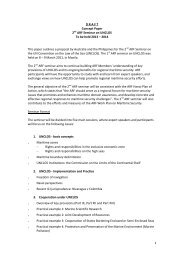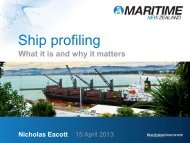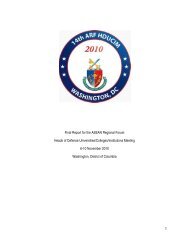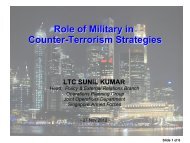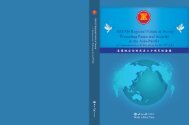ANNEX D - Singapore presentation.pdf - ASEAN Regional Forum
ANNEX D - Singapore presentation.pdf - ASEAN Regional Forum
ANNEX D - Singapore presentation.pdf - ASEAN Regional Forum
You also want an ePaper? Increase the reach of your titles
YUMPU automatically turns print PDFs into web optimized ePapers that Google loves.
<strong>ANNEX</strong> D<strong>Singapore</strong>: Maritime Security Capacity BuildingDistinguished colleagues, ladies and gentlemen, a very good morning. First, allow me tothank the Australian Department of Defence for its warm hospitality and excellentarrangements made for his meeting. Today, I hope to share <strong>Singapore</strong>’s approach tomaritime security as well as the cooperation that we are pursuing in this area.IntroductionMaritime security is an issue of strategic importance, particularly to countries in the Asia-Pacific, as some of the world’s most important shipping lanes and trade routes, includingthe Straits of Malacca and <strong>Singapore</strong> pass through the region. The security of thesewaters is not only vital to economic prosperity, but also carries strategic implications forthe freedom of navigation in the sea lines of communication. As a country heavily relianton international trade and possessing one of the world’s busiest ports, ensuring maritimesecurity is a key national interest for <strong>Singapore</strong>. The navies have traditionally been thefirst responders to deal with any maritime security challenges because they possess thecapabilities to do so. However, with the more complex security environment that we havebeen facing in recent years, the range of potential threats in our strategic waterways hasexpanded – ranging from petty theft to more violent acts including piracy and seajacking, to possible terrorist attacks. In this regard, the onus is no longer just on thearmed forces, or the navies, to address these security threats on their own. Increasingly,more and more countries have recognised that the safety and security of our seas is to befounded on strong inter-agency cooperation and greater international collaboration.<strong>Singapore</strong>’s Whole-of-Government Approach to Maritime Security<strong>Singapore</strong> views maritime security as an extremely complex issue that cuts acrossinternational boundaries, agency boundaries as well as disciplinary boundaries. Anycomprehensive solution would require many players to act in concert, includingmilitaries, enforcement agencies, port authorities, policy makers and the shippingindustry. The solution would also have to balance economic and security needs so as tobe sustainable. 2. <strong>Singapore</strong>’s approach to maritime security is centred on inter-agencycooperation and coordination. Domestically, the key players include the Republic of<strong>Singapore</strong> Navy (RSN), the Police Coast Guards (PCG), the Maritime Port Authority(MPA) and they work closely with the Ministries of Defence, Foreign Affairs, HomeAffairs and Transport to facilitate a strategy in enhancing situational awareness, developa range of deterrence measures and a range of flexible and calibrated responsecapabilities. They also work with the defence technology agencies to pool together thevarious domains of expertise, experiences and ideas to overcome blind spots andunwitting gaps, and to develop more risk reduction solutions.MSTFTo ensure that we are better able to address this challenge, the Republic of <strong>Singapore</strong>Navy has restructured its Coastal Command (COSCOM) into an armed forces-level taskforce, known as the Maritime Security Task Force or the MSTF. The creation of theMSTF is to enhance inter-agency cooperation, allowing the cross-domain capabilities ofthe SAF and the other national maritime agencies to be leveraged upon to conductcalibrated and flexible operations to counter maritime security threats. Besides round-theclockpatrols by RSN patrol vessels, the radar and electro-optical sensor network of theMaritime Port Authority and the Police Guard are also being tapped on to maintainconstant surveillance of <strong>Singapore</strong>’s waters. A new National Maritime Security System(NMSS), led by the MSTF, has also recently been established to promote even strongerinformation sharing, situation awareness, decision-making and operational coordination
among our maritime security agencies. This will enable <strong>Singapore</strong> to respond moreeffectively to a wider spectrum of maritime threats.Information Fusion Centre (IFC)To further build capacity and catalyse maritime security collaboration in the Asia Pacificregion, especially in the area of information sharing, the <strong>Singapore</strong> Navy has establishedthe Information Fusion Centre or IFC in April 2009, as part of the Changi Command andControl Centre. The IFC is unique in that it is a hot set-up operated around the clock byan integrated international team, comprising International Liaison Officers (ILOs) frompartner countries working with our RSN personnel to facilitate maritime info-sharingcooperation and collective sense-making. As the single Point of Contact, the ILOsprovide a reach-back to their respective operational centres to access, share maritimeshipping information and prompt collaborative action where applicable. In addition, theILOs collaborate with other ILOs when maritime incidents occur. Thus far, the IFC hashad ILOs from ten countries deployed there, including from Australia, France, India,Malaysia, New Zealand, the Philippines, 3 Thailand, UK, US and Vietnam. The IFC alsohas linkages with 38 agencies in 25 countries, enabling it to tap on information from awide range of sources. The distinctive feature at IFC is that it monitors a coherent nearreal-time recognised maritime situation picture. Focusing on the Asia Pacific region, theIFC monitors the daily happenings in the maritime domain, sense-making the informationcollated from the extensive database linkages established with its maritime partners,shipping community as well as open sources. To facilitate and catalyse informationsharing in this region, the IFC has been conducting various confidence and capacitybuilding activities, from workshops, to information-sharing exercises, such as WPNSMaritime Security Information-Sharing Exercise or MARISX. The aim of these activitiesis to provide greater awareness, increase interoperability amongst the different maritimepartners by reinforcing the utility of information sharing.Malacca Strait PatrolsAn example of how the advancement of information sharing between partner navies andmaritime agencies in the region has been successfully applied can be seen in the MalaccaStraits Patrols, or MSP. This is a cooperative initiative consisting of coordinated air andsea patrols from the littoral states of Indonesia, Malaysia, <strong>Singapore</strong> and Thailand whichis supported by an online portal for information-sharing. Such collaboration occurs on adaily basis, as information exchange takes place constantly between the Monitoring &Action Agencies (MAA) of the four partners. Active information sharing, includinginformation provided by the shipping community through a voluntary reporting system,allow the countries to coordinate the operational patrols and hand-over specific vesselwhich were tracked to ensure the safety and security of the targeted merchant ships.ConclusionWithin <strong>Singapore</strong>, we have put in place a strong inter-agency process that allows us torespond in a robust manner to any maritime security challenges. Beyond domesticcoordination, we also work with many other likeminded countries, both bilaterally andmultilaterally, to ensure the safety and security of our seas. This will help to buildcommunication and inter-operability between the relevant agencies – civilian, military orthe shipping industry - so that we will be able to respond coherently and effectively whenconfronted by maritime crises.Thank you.. . . . .


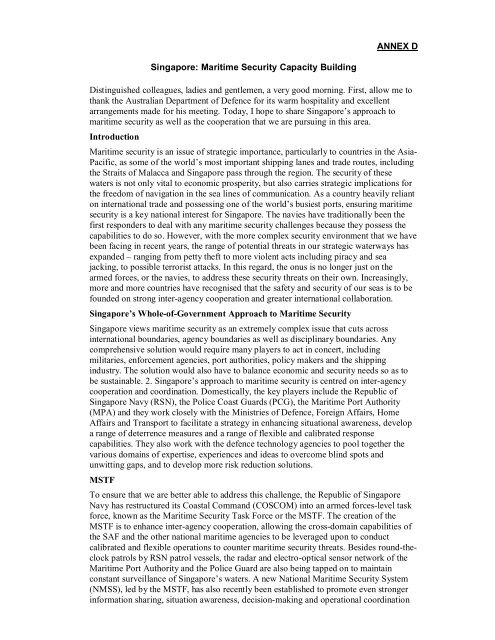
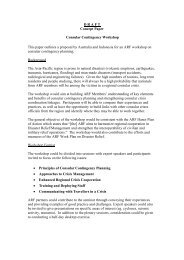
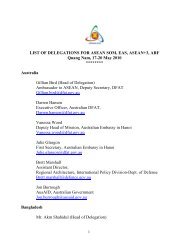

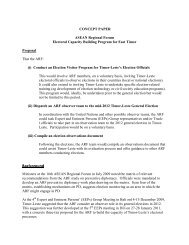
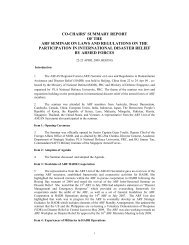
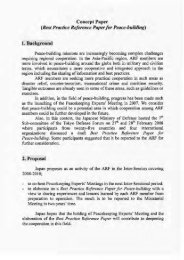
![10 ASAIN Presentation [Pakistan].pdf - ASEAN Regional Forum](https://img.yumpu.com/50649810/1/190x143/10-asain-presentation-pakistanpdf-asean-regional-forum.jpg?quality=85)
